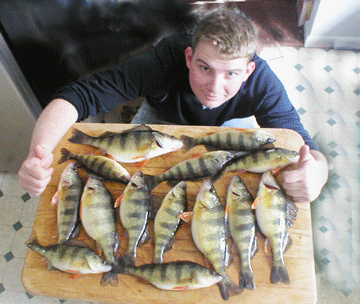
|
Volume XVII, Issue 13 - March 26 - April 1, 2009
|
|
Columns Reviews |
 |
| Our trifecta bet paid off with a furious perch bite. |
Reaching Eldorado
At last, we’ve filled our chests with gold
Our fingers were crossed as I dropped anchor at our favorite spot on the Choptank. High up in the river, we were just below an inside edge where the waters narrowed, curved abruptly to the right above us, then opened up into a large shallow pool.
As I cleated the anchor line and the boat swung down tight with the current, I saw Mike’s cast arc out. His minnow-tipped spoon settled a few feet from the base of a big tree leaning out from an undercut bank. A rope swing hung from a thick branch over the 12-foot depth that had been carved out of the riverbed by the relentless current.
I hurried to get my own cast out, but before I could I saw Mike’s rod tip surge down. “Whoa,” was all he said. Instant action. My heart thumped as I made my cast. Could this be the day?
 |
Our trifecta bet paid off with a furious perch bite. |
![]() My lure had hardly settled when I felt the hit of a good fish. Playing it carefully on my light rod, I caught sight of Mike’s fish as he managed it into the boat. It was a yellow perch, female, bulging fat — and if it wasn’t a foot long it wasn’t an inch.
My lure had hardly settled when I felt the hit of a good fish. Playing it carefully on my light rod, I caught sight of Mike’s fish as he managed it into the boat. It was a yellow perch, female, bulging fat — and if it wasn’t a foot long it wasn’t an inch.
My own hookup made the next few minutes of my life very interesting as the fish surged deep, then downstream, then under the boat and finally into the net. It was a lovely male yellow, as big as the one my partner had landed. In the meantime, Mike was already hooked up with another obviously good fish.
I put a fresh minnow on my small spoon and fired out a cast. It got hit as soon as it splashed into the water. Four casts, four fish: The game was definitely on.
We had done well fishing for yellow perch in the past few weeks, but we’d had no single outstanding day. The peaks of a yellow-perch run are difficult to predict, though we did not lack for trying.
Picking the Trifecta
Biologically, the perch are affected first by photoperiod. No matter what the water temperatures or weather conditions, it is the length of the day that initiates their first urges to school, then journey upstream toward natal waters.
Next, water temperature plays a critical role, with the optimum for spawning between 46 and 50 degrees.
Between those two events come the movement and staging periods as the fish surge up the rivers and streams, pause in hidden locations and await nature’s signal to procreate. The river’s entire population of perch does not act at once. Each school or group of schools has its unique timetable.
The critical trigger event for any one group may be a surging tide, a sudden temperature spike, a burst of sunshine, a springtime downpour, a particular moon phase, or a combination of these. Or maybe something else we haven’t considered.
I don’t think anyone knows with any certainty which particular conditions create the critical tipping point. But one thing is sure: Every few days during early spring, a large number of big yellow perch will suddenly appear high in the headwaters, spawn, then disperse.
This time we were betting on a triple coincidence of events: a full moon; the last two hours of a flooding tide at sunrise; and a predicted 60-plus-degree morning. Our trifecta paid off. Slacking only as the tide peaked, then resuming as current returned, a furious perch bite continued until late in the morning.
Like the fabled city of gold, at the end of this sortie the fish box held Tidewater treasure of glowing, glistening yellow perch.
Fish Are Biting
The yellow neds are peaking now, and the white perch surge has begun in earnest. Minnows, grass shrimp and worms are all effective baits. Bank fishers on the Western Shore at Blackwater, Allen’s Fresh, Blackwalnut, the Severn, the Magothy and up into Deer Creek and the head of the Susky are all catching. On the Eastern Shore, the Chester, the Choptank, Tuckahoe, the Wye and Wye Mills are places to try.
Spring is here. The winter witch is dead, and the Tidewater’s fishing seasons spread out before us.
Environmental Anguish
The Chesapeake Bay Foundation’s annual report on the health of the Bay has been released for this year, and guess what? We flunked again. Bay watchers have pronounced the Chesapeake a mess and the collective efforts of elected officials and responsible bureaucrats ineffective. So do I.
We know the major sources of pollution, we know what is killing the Bay grasses and poisoning the water, we know who is depleting Chesapeake Bay’s oysters, clams, crabs and fish … and we know what has to be done. But we never do it. Immediate recovery could begin with prompt legislation and strict enforcement. Don’t count on it.